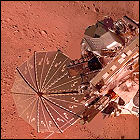 Radio signals from the Martian surface indicating the successful landing of NASA’s unmanned Phoenix probe near the north pole of Mars. (To put this feat in perspective: the past several unmanned probes to land safely on Mars used a “bouncing airbag” approach; the last time a lander actually made it to the surface intact with braking thrusters and landing pads – and no airbags – was in 1976, when NASA’s Viking 1 and 2 landers successfully touched down on the planet.) The first stationary (i.e. non-rover) Mars lander since the Viking probes of the 1970s, Phoenix will stay in one spot to conduct three months of studies. Also like the Vikings, Phoenix has a soil-sampling arm and an on-board laboratory to help it determine the presence of water or water ice in its polar vicinity.
Radio signals from the Martian surface indicating the successful landing of NASA’s unmanned Phoenix probe near the north pole of Mars. (To put this feat in perspective: the past several unmanned probes to land safely on Mars used a “bouncing airbag” approach; the last time a lander actually made it to the surface intact with braking thrusters and landing pads – and no airbags – was in 1976, when NASA’s Viking 1 and 2 landers successfully touched down on the planet.) The first stationary (i.e. non-rover) Mars lander since the Viking probes of the 1970s, Phoenix will stay in one spot to conduct three months of studies. Also like the Vikings, Phoenix has a soil-sampling arm and an on-board laboratory to help it determine the presence of water or water ice in its polar vicinity.
Tags:
Categories
Comments are closed